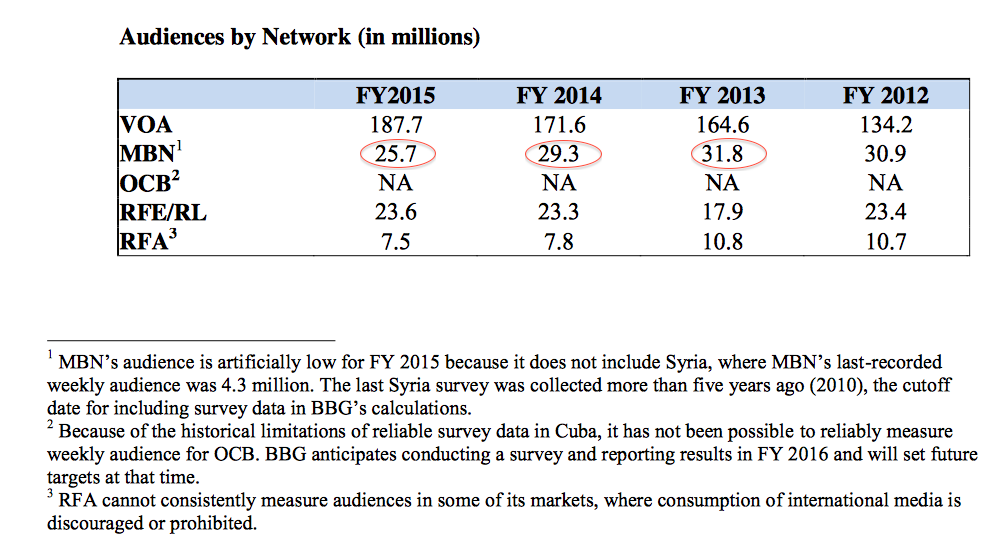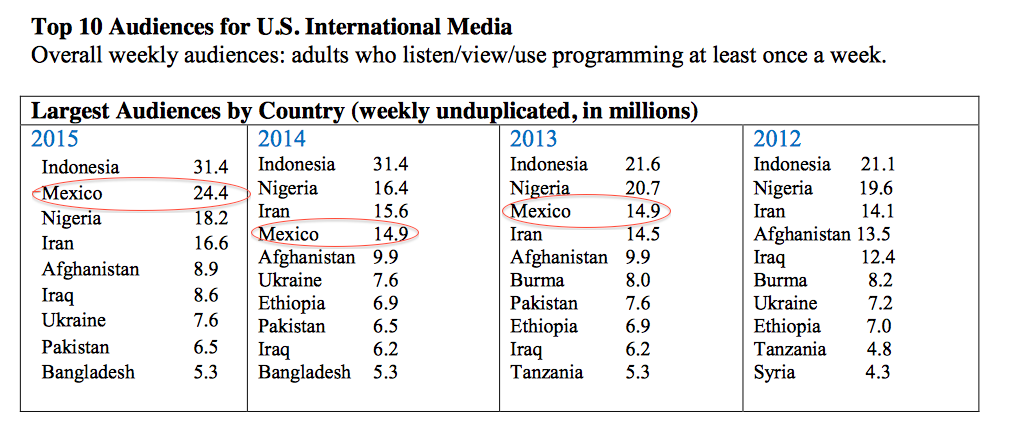BBG Watch Commentary
Officials running US Broadcasting Board of Governors (BBG), U.S. government’s overseas media outreach federal agency, have once again resorted to making dishonest audience claims in an attempt to mislead their bipartisan oversight board, their new CEO John Lansing, and the U.S. Congress. American taxpayers who are paying salaries of these bureaucrats and supporting the agency to the tune of $740 million each year.
Just before BBG Chair Jeff Shell and BBG CEO John Lansing were to testify last week before the Senate Committee on Foreign Relations chaired by Senator Bob Corker, BBG officials issued a press release which triumphantly claimed an “unprecedented weekly measured audience of 226 million.” They called their estimates annual “impact numbers.”
A closer examination of their claims, however, shows that in terms of impact in strategic countries and regions, BBG’s audience, particularly for its flagship broadcaster — the Voice of America (VOA) and Arab-language broadcasting to the Middle East by Alhurra TV and Radio Sawa — have remained stagnant or declined over the years, especially when global population growth is taken into account.
This is what BBG bureaucrats did. They said that the BBG has increased its audience to “unprecedented” 226 million. Technically, they did not lie about the number if one accepts their estimates at face value (many, including VOA journalists, don’t), but they definitely did not tell the whole truth how their estimates were made and what they encompass. 24.4 million of the audience came from Mexico, and other millions were for programs from which newscasts had been intentionally eliminated by the BBG to satisfy local censors.
If Mexico, a troubled but democratic nation which has plenty of ties to the US and relatively free press, is not included in the audience count, BBG’s overall reach in the most strategic countries and regions has been at best stagnant or declining (considering global population growth) for years.
Another large VOA audience claimed by BBG officials is in Indonesia (31.4 million). Without Mexico and Indonesia, VOA’s global audience is quite small — 132 million — about the same as in 1989, when it was 130 million, but then mostly to countries without any free media, and nearly always with full newscasts and uncensored political programs.
Indonesia is a Muslim country, but it is relatively friendly toward the United States. Even there, VOA TV placement programs are reportedly self-censored by VOA to satisfy the Indonesian government. The BBG reportedly pays for such program placement using US taxpayers’ dollars.
If we are not worried about self-censorship and violations of the VOA Charter, one could argue that such placement may have some limited impact. It perhaps satisfies one element of the VOA Charter — reporting on some, but not all aspects of American life — while violating another element of the Charter. The danger is that such self-censored VOA programs present US viewpoints and America in a skewed and possibly inaccurate manner when sensitive topics are not mentioned or discussed.
Instead of self-censoring soft VOA programs or simply reporting on what stations in countries like Mexico want from VOA, it would certainly make more sense for the U.S. government to try to expand impact and BBG audience in much more critically important and “unfriendly” countries: in the Middle East, Russia, China, and even among Arab-speakers in Western Europe. The focus should be anyway primarily on impact where it counts the most, not on audience reach at any cost or at any compromise. But the impact is not being measured by the BBG. If it were measured, it would show tremendous losses for the United States and the agency.
To call their audience estimates “impact numbers,” when BBG officials know very well that some of the Voice of America programs are directed to non-strategic countries like Mexico in terms of U.S. taxpayer-funded media outreach priorities — a country which has a democratically elected government and relatively free media despite journalists being killed — and/or these VOA local placement programs have been stripped of news by VOA and BBG, is simply dishonest.
Without Mexico, VOA’s global weekly audience in FY2015 is only 163 million, less then it was in FY2013 (164.6 million when it already included 14 million from Mexico). In FY2012, when there was no Voice of America audience in Mexico and less self-censored local VOA program placement, VOA global weekly audience was only 134 million.
Why BBG bureaucrats continue to expand local paid placement of mostly soft programs (on local radio and TV networks), from which in many cases news or certain politically sensitive news is excluded to satisfy local government censors and station owners?
They do this because it is easy, and it is the easiest way to show audience growth. Otherwise these programs could not be broadcast locally and produce bigger audience numbers the BBG bureaucracy wants, whether there is impact or not. Mission “impact” is certainly not included or shown in those “unprecedented” BBG audience estimates, which are not “unprecedented” at all.
BBG officials have definitely not achieved an “unprecedented” audience for programs truly consistent with the BBG’s mission and all the provisions of the VOA Charter. These facts and observations should have been made clear by them in the BBG press release. They were not made.
VOA and BBG audience now is also by no means “unprecedented” when adjusted for global population growth over the last 25 years, as well as the general growth of online audiences for international broadcasters — an area in which the BBG has failed spectacularly.
VOA English News had less than 10 Facebook posts the weekend of the Paris terror attacks. Compared to Russia’s RT, BBC and Germany’s DW, which had dozens of Paris-related news reports, VOA got during that period only 1 percent of “Likes” and readers’ comments in the category of Paris terror-related Facebook posts. While RT may be using trolls to beef up its social media statistics, we doubt that BBC and DW do. Even if RT is using trolls, there is little doubt that it still has far better audience engagement numbers than VOA, particularly on YouTube, but also on its own website, Facebook and Twitter.
Looking at dismal social media audience engagement statistics for the Voice of America, which are generated externally by social media outlets and thus cannot be manipulated by BBG officials to make themselves look good, one wonders how accurate any of their inflated audience estimates may be. After all, their jobs, pay and bonuses depend to at least some degree on showing audience growth.
In 1989, VOA had an estimated weekly audience of 130 million, composed almost entirely at that time of radio listeners overseas. The world population grew from 5.2 billion in 1989 to 7.2 billion in 2015. If we don’t count VOA audience in Mexico and in Indonesia, where VOA placement programs reportedly do not include live news, then VOA audience size now and in 1989 are practically the same despite a tremendous growth in world population and the emergence of entirely new digital media platforms. In 1989, nearly all VOA programs, then nearly all radio, included live newscasts. One also cannot get a clear answer from BBG bureaucrats whether they now include US web audiences in their estimates. In 1989, no US broadcasting audience of any kind was included in VOA audience estimates.
Even if one accepts current estimates made by BBG officials — they show a slight gain for RFE/RL and also gains in audience in Iraq and Iran; a decline in Afghanistan and no change in Pakistan — BBG’s own figures also show between FY2013 and FY2015 a definite decline in audience size for Middle East Broadcasting Networks’ (MBN) Radio Sawa and Alhurra TV programs. This is the agency’s strategically most important target region. What does it say about the agency’s impact?
Instead of spending money on dubious program placement in Mexico, BBG bureaucrats should have tried to develop programs and placement strategies targeting Arab speakers in Western Europe and improving MBN performance. They also should have cut their own budget and made funds available to program producers at MBN, RFE/RL, RFA, OCB, and VOA.


